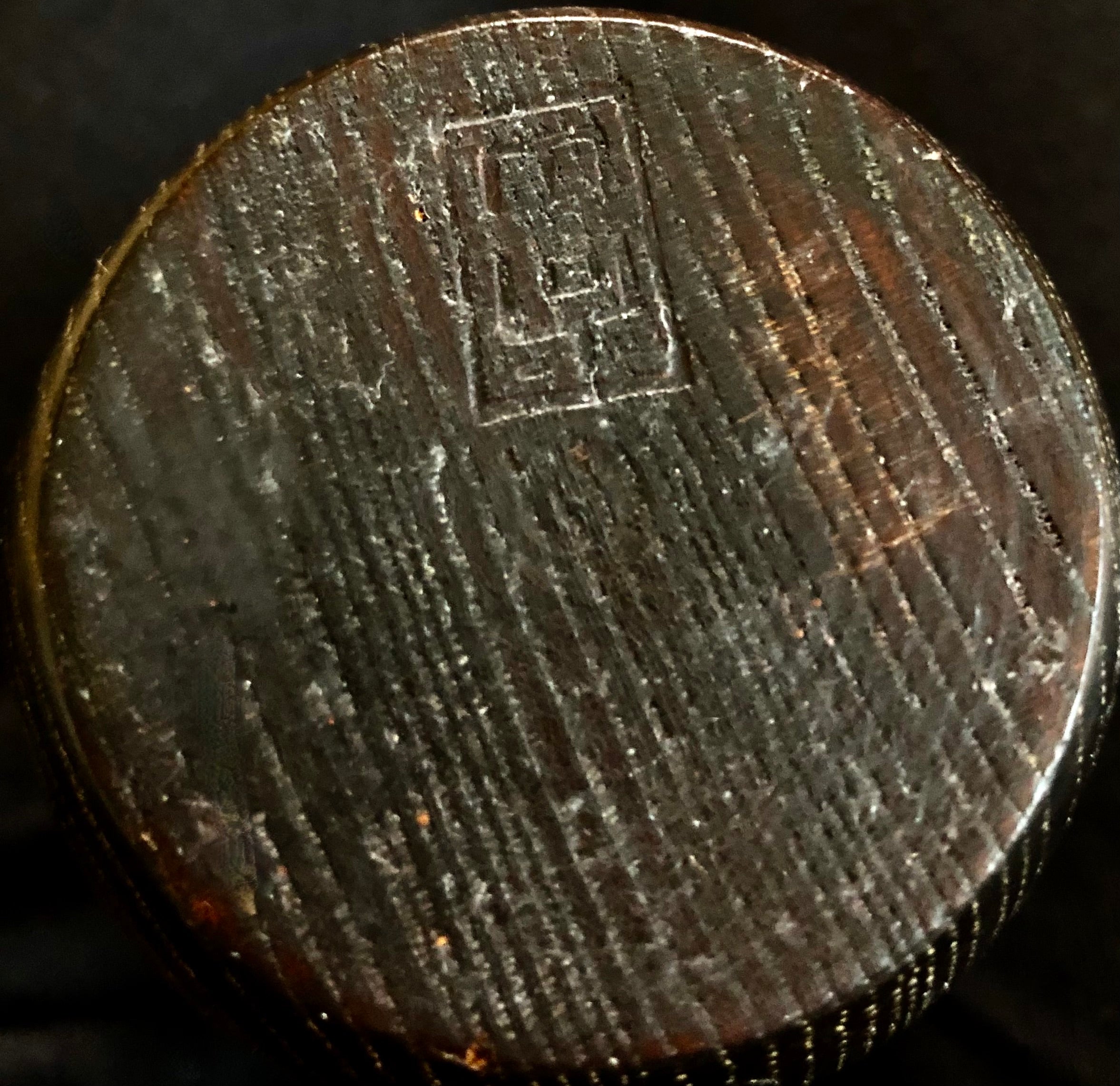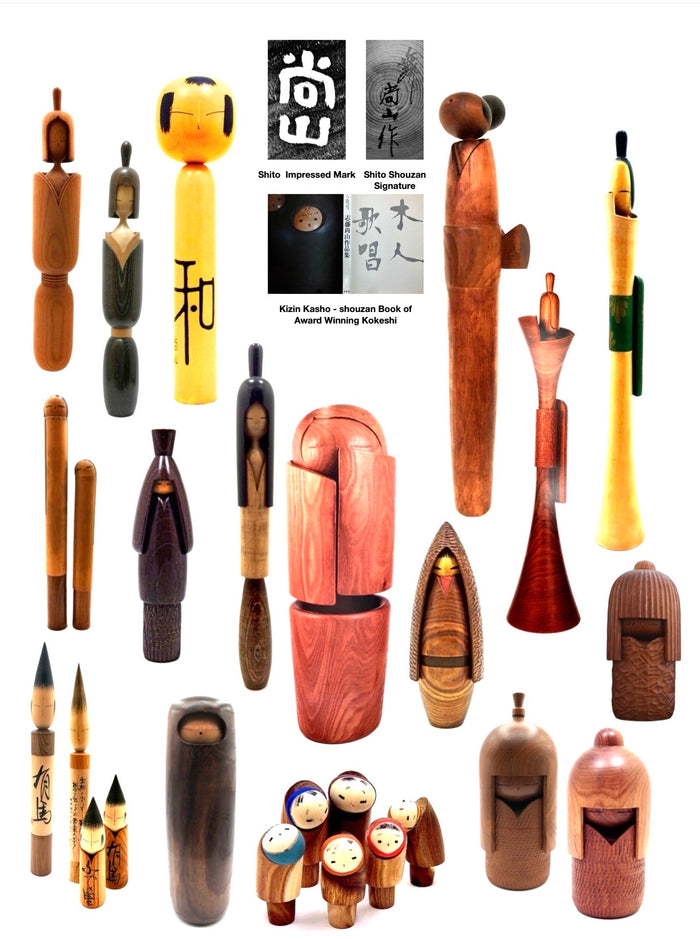




Vintage Japanese Sosaku Kokeshi entitled: “Hatsune | A Lady” by Shouzan, Shido
Dimensions: 19-1/2”h
This is an exceptional and “rare” vintage Sosaku Kokeshi by Shouzan-san who loved studying the use of combining different types of wood to gain the desired effect and to give dimension to his pieces. This doll incorporates the use of Paulownia, Beech, and Cherry. He also emphasized his enjoyment of creating slender, tall dolls to support the fact that they resemble the tall, thin trees seen throughout Japan.
Here we see an extremely unusual type of headdress, called a ‘Tsunokakushi’, inspired by samurai headgear worn in battle in the medieval age. It is a wide hood type of design, topped with a ‘Mage’, (topknot inspired by samurai headgear worn in battle in the medieval age). As in real life, the traditional layering of clothing is shown through delicate carving techniques, including the narrow carved and undecorated Obi. The figure shows the use of a double-layered kimono with a neckline that is cut lower, cut to expose the thin, with an exaggerated neck. The face on this doll is understated, with two tiny red dots for a nose. The doll has Shouzan's signature stamp on the bottom.
NOTE: This Kokeshi by Shouzan was published and cited as a Japanese competition winner for which a group of Sosaku Kokeshi that were introduced in the United States to the American public under the auspices of the Japan Society of New York, and hosted by JETRO (Japan External Trade Organization). The catalog entitled: Kokeshi Dolls From Japan,(Printed by DOBI Printing Co., Ltd. Japan), citing 232 Kokeshi, with selected designer photography, for which the image of the piece was as number 14 of the catalog with the artist/designer, name of the doll, (English and Japanese), and the size of the doll. A very rare historical documentation of the first Sosaku Kokeshi proudly recognized by the Japanese government.
Condition: A mint condition exhibiting an aged patination and meticulous care. There are no missing elements, no scratches or imperfections related to daily use with all detailed elements intact. The object retains the original craftsmanship, meeting the standards of the collector of Japanese Sosaku Kokeshi.

Artisan
Woodworker: Shido, Shouzan
1932-1995
Biographical History:
Shouzan began making Sosaku Kokeshi in 1959, soon after he graduated from Chuo University with a law degree. He is considered by Kokeshi collectors and critics alike to be arguably the most influential artist in the world of Sosaku Kokeshi doll-making. Shido-san’s main focus was depicting unadorned Northern girls in the traditional “Mino”, or Snow Coat, but he also produced tall, thin dolls, which were sparsely decorated. His keen sense of design, minimal use of color, and simple elegant shapes set him apart from his peers, making him one of the most collectible artists emerging from the creative period of the ‘60s winning various awards since 1961. He served as a judge of the All Japan Kokeshi Contest from 1970 to 1976. During that time Shozan published a book entitled Kizin Kasho comprising examples of his award-winning Kokeshi. His dolls have been collected and exhibited worldwide and winner of the Prime Minister’s Award, among many other awards.
Collector's note – descriptive qualities, standard characteristics & ornamentation styles:
Shito-san loved studying the use of combining different types of wood to gain the desired effect and to give dimension to his pieces. He also enjoyed creating slender, tall dolls to support the fact that they resemble the tall, thin trees seen throughout Japan. He incorporated a repetitive textural pattern called ‘Harmonic Chatter work’ to enhance the natural qualities of the wood in many of his works. He particularly enjoyed the textural qualities of ‘Chattering’ on the rain/snow coat, (Minomushi), which is a favorite theme, executed with minimal painted ornamentation, with an emphasis on the natural wood. In general, it is said that Japanese culture is one of modesty and humility. Occasionally saw different types of headdresses, one of which he called a ‘Tsunokakushi’, which is a wide headdress or hood, that covered elaborate hairstyles. We are told that the Japanese people regulate their behavior and response by reading faces and the eyes of others. Here, as well as elsewhere, you will see many examples of different characteristics of the eye's expressions. His most famous doll, which was considered a favorite was called “Mai”, a dancer, which was an elegant and slender doll with a beautifully formed Kimono focusing on traditional hair design (Mage) with an emphasis on a brightly colored “obi” which brings forth the best use of complex geometry to create traditional Japanese clothing elements which were created in 1970.
Shito-san was a prolific artist/woodworker of Kokeshi dolls some of which were whimsical, some focusing on calligraphy citing haiku (poems). We additionally see unusual subjects focused on Zen Buddhism and figures of Daruma, (Bodhidharma) of which most were made in a “roly-poly” type figure seen throughout festivals in Japan.
Explore & Learn More about Woodworker: Shido, Shouzan